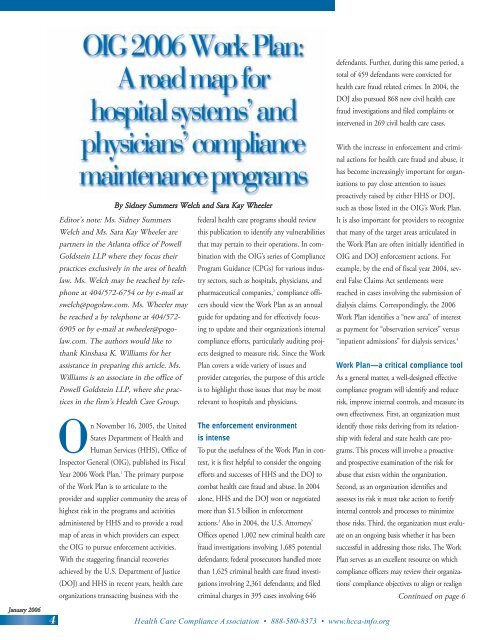MD - Health Care Compliance Association
MD - Health Care Compliance Association
MD - Health Care Compliance Association
You also want an ePaper? Increase the reach of your titles
YUMPU automatically turns print PDFs into web optimized ePapers that Google loves.
defendants. Further, during this same period, a<br />
total of 459 defendants were convicted for<br />
health care fraud related crimes. In 2004, the<br />
DOJ also pursued 868 new civil health care<br />
fraud investigations and filed complaints or<br />
intervened in 269 civil health care cases.<br />
By Sidney Summers Welch and Sara Kay Wheeler<br />
Editor’s note: Ms. Sidney Summers<br />
Welch and Ms. Sara Kay Wheeler are<br />
partners in the Atlanta office of Powell<br />
Goldstein LLP where they focus their<br />
practices exclusively in the area of health<br />
law. Ms. Welch may be reached by telephone<br />
at 404/572-6754 or by e-mail at<br />
swelch@pogolaw.com. Ms. Wheeler may<br />
be reached a by telephone at 404/572-<br />
6905 or by e-mail at swheeler@pogolaw.com.<br />
The authors would like to<br />
thank Kinshasa K. Williams for her<br />
assistance in preparing this article. Ms.<br />
Williams is an associate in the office of<br />
Powell Goldstein LLP, where she practices<br />
in the firm’s <strong>Health</strong> <strong>Care</strong> Group.<br />
On November 16, 2005, the United<br />
States Department of <strong>Health</strong> and<br />
Human Services (HHS), Office of<br />
Inspector General (OIG), published its Fiscal<br />
Year 2006 Work Plan. 1 The primary purpose<br />
of the Work Plan is to articulate to the<br />
provider and supplier community the areas of<br />
highest risk in the programs and activities<br />
administered by HHS and to provide a road<br />
map of areas in which providers can expect<br />
the OIG to pursue enforcement activities.<br />
With the staggering financial recoveries<br />
achieved by the U.S. Department of Justice<br />
(DOJ) and HHS in recent years, health care<br />
organizations transacting business with the<br />
federal health care programs should review<br />
this publication to identify any vulnerabilities<br />
that may pertain to their operations. In combination<br />
with the OIG’s series of <strong>Compliance</strong><br />
Program Guidance (CPGs) for various industry<br />
sectors, such as hospitals, physicians, and<br />
pharmaceutical companies, 2 compliance officers<br />
should view the Work Plan as an annual<br />
guide for updating and for effectively focusing<br />
to update and their organization’s internal<br />
compliance efforts, particularly auditing projects<br />
designed to measure risk. Since the Work<br />
Plan covers a wide variety of issues and<br />
provider categories, the purpose of this article<br />
is to highlight those issues that may be most<br />
relevant to hospitals and physicians.<br />
The enforcement environment<br />
is intense<br />
To put the usefulness of the Work Plan in context,<br />
it is first helpful to consider the ongoing<br />
efforts and successes of HHS and the DOJ to<br />
combat health care fraud and abuse. In 2004<br />
alone, HHS and the DOJ won or negotiated<br />
more than $1.5 billion in enforcement<br />
actions. 3 Also in 2004, the U.S. Attorneys’<br />
Offices opened 1,002 new criminal health care<br />
fraud investigations involving 1,685 potential<br />
defendants; federal prosecutors handled more<br />
than 1,625 criminal health care fraud investigations<br />
involving 2,361 defendants; and filed<br />
criminal charges in 395 cases involving 646<br />
With the increase in enforcement and criminal<br />
actions for health care fraud and abuse, it<br />
has become increasingly important for organizations<br />
to pay close attention to issues<br />
proactively raised by either HHS or DOJ,<br />
such as those listed in the OIG’s Work Plan.<br />
It is also important for providers to recognize<br />
that many of the target areas articulated in<br />
the Work Plan are often initially identified in<br />
OIG and DOJ enforcement actions. For<br />
example, by the end of fiscal year 2004, several<br />
False Claims Act settlements were<br />
reached in cases involving the submission of<br />
dialysis claims. Correspondingly, the 2006<br />
Work Plan identifies a “new area” of interest<br />
as payment for “observation services” versus<br />
“inpatient admissions” for dialysis services. 4<br />
Work Plan—a critical compliance tool<br />
As a general matter, a well-designed effective<br />
compliance program will identify and reduce<br />
risk, improve internal controls, and measure its<br />
own effectiveness. First, an organization must<br />
identify those risks deriving from its relationship<br />
with federal and state health care programs.<br />
This process will involve a proactive<br />
and prospective examination of the risk for<br />
abuse that exists within the organization.<br />
Second, as an organization identifies and<br />
assesses its risk it must take action to fortify<br />
internal controls and processes to minimize<br />
those risks. Third, the organization must evaluate<br />
on an ongoing basis whether it has been<br />
successful in addressing those risks. The Work<br />
Plan serves as an excellent resource on which<br />
compliance officers may review their organizations’<br />
compliance objectives to align or realign<br />
Continued on page 6<br />
January 2006<br />
4<br />
<strong>Health</strong> <strong>Care</strong> <strong>Compliance</strong> <strong>Association</strong> • 888-580-8373 • www.hcca-info.org

















